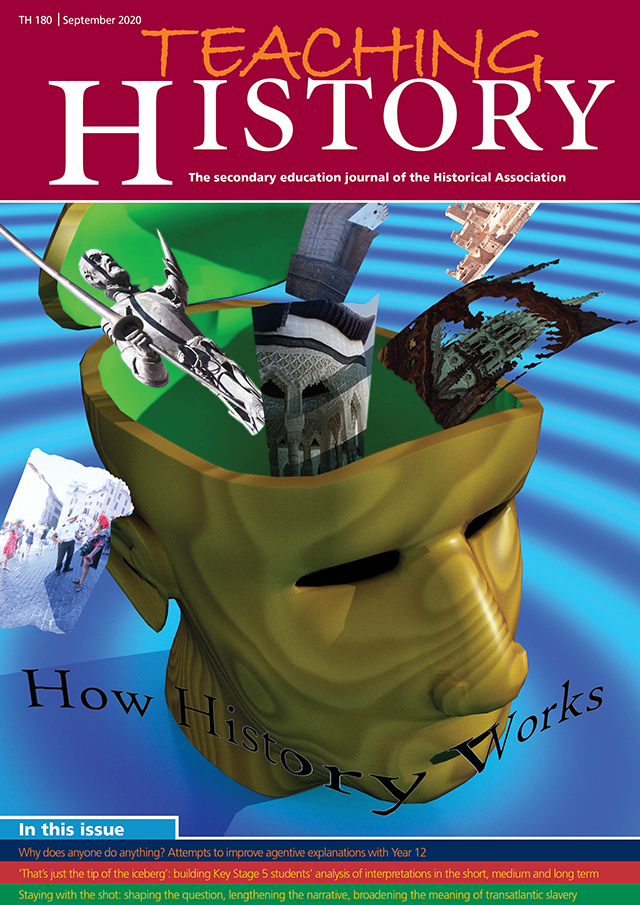Teaching History 180: Out now
The HA's journal for secondary history teachers

Editorial: How History Works
The start of a new academic year, with all its comfortingly familiar rituals and routines, also brings with it a set of familiar feelings: the adrenaline rush that comes with last-minute preparations, the thrill (and nerves) of meeting new classes, the sheer pleasure of being back in the classroom. This year those emotions are heightened by the unprecedented circumstances we find ourselves in: relief at finally having all pupils in school is tempered by trepidation about the uncertainties and challenges of the year that lies ahead.
While the routines that normally govern school life will, for many, look very different and teachers will need to continue to adapt and innovate in order to respond to the new normal, it is heartening that curricular conversations among history teachers are continuing unabated. A common concern evident in contributions to recent editions has been the relationship between the school subject and ‘history’, especially as it is practised as an academic discipline. This edition develops that theme by exploring the processes, mechanisms and conventions that underpin its production.
Yet, as Husbands pointed out back in 1996, history can be pursued in many different ways, and the label ‘history’ is an ambiguous one that can have different meanings in different contexts.1 To question, as many of the authors of this edition do, how history ‘works’ is therefore to implicitly question how history should be defined. Here many of the authors go beyond narrow or simplistic definitions of history as purely an academic discipline, acknowledging the porous nature of its disciplinary borders as well as what Trouillot calls its many, overlapping, sites of production.2
A concern with how history works inevitably feeds ongoing conversations about the selection of content, emphases and perspectives in our curricula. After all, as the historian Rublack has pointed out:
…we cannot approach questions about the status of historical knowledge other than by embedding our query in a sense of practices of knowledge making, instruments, and work environments.3
If we want pupils to be able to question conventions and canons, then developing an understanding of how history works – how and where it is produced and by whom, and in what institutional and social contexts – is critical to achieving that aim.
This is exactly what Nathanael Davies set out to do when he planned an enquiry on British colonial slavery. Davies shows how, through a process of dialogue with historians and other teachers, he began to question conventional approaches to teaching the history of British colonial slavery. Grounding his enquiry planning in current scholarship he shows how, by challenging periodisations that end the story of British involvement in slavery in 1833, he was able to ask a different question of the period that in turn enabled pupils to problematise the conventional self-congratulatory narratives that dominate collective and public memories of the British empire.
Jess Angell was also concerned with broadening pupils’ view of what history is, and how and by whom it is produced, but explores these issues in the context of the curriculum as a whole. She gives an account of how her department has sought, through a wide-ranging programme of extracurricular enrichment, to introduce all pupils to the many different ways and contexts in which history can be pursued.
Several authors are concerned with narrowing the gap between the way disciplinary processes are taught in school and the way they are practised by historians. All seek to problematise the notion of history as a unified, monolithic discipline, instead seeking to show through specific examples divergences in conventions and practice.
Jonathan Sellin drew inspiration from the practices of intellectual historians in general and the work of the Cambridge School of historians in particular to devise a practical approach for teaching pupils how historians read for meaning when interpreting written texts as speech acts. In doing so he shows that moving away from treating evidential thinking as a generic skill to teaching pupils about the work of particular professional communities of practice can lead to richer, more rewarding work with sources in the classroom by pupils themselves.
Samuel Head and Sophie Harley-McKeown also sought to challenge their pupils’ tendencies towards genericism in their explanations. Head was concerned with developing his A-level students’ explanations of variations in historians’ accounts while also equipping them to meet the demands of the A-level examination. He developed a practical model, an iceberg metaphor, that offered a step-by-step process for evaluating differing interpretations while (at the same time) encouraging students to get beyond simplistic analysis. Harley-McKeown wanted to develop her students’ own causal explanations by adding complexity to their understanding of what a cause is, and showing how causal explanation differs from explanation of motive. She adapted an existing practical model, a causal ‘dartboard’, thereby offering a powerful example of how history teachers draw on others’ theorisation to develop their own practice. Similarly, Laura Tilley sought to devise a practical process, loosely modelled on historians’ practices, that pupils could follow in order to frame, research and produce their own accounts.
Michael Hill drew inspiration from other disciplinary fields in order to tackle stubborn weaknesses in his pupils’ historical knowledge. Noticing that pupils struggled to construct a coherent picture of the past, he borrowed from history-teacher research, literary and media theory, and philosophy to theorise how teachers can shape pupils’ imagined pasts.
References
1 Husbands, C. (1996) What Is History Teaching? Language, ideas and meaning in learning about the past, Buckingham: Open University Press, p. 5.
2 Trouillot, M. (1995) Silencing the Past: power and the production of history, Boston, Mass.: Beacon Press, p. 19.
3 Rublack, U. (2012) A Concise Companion to History, Oxford: Oxford University Press, p. 68.

